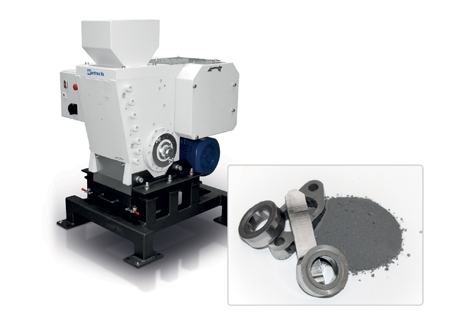
Reusing raw materials is an important factor in powder metallurgical processes. Retsch offers a range of instruments that are suitable for sieving powders and pulverizing metal parts, both of which are reintroduced into the production process. The following examples describe the suitability of Retsch instruments for these applications:
Separation of size fractions by sieving to recover metal powder residues after 3D printing using laser technology:
 Retsch sieve shakers, such as the Vibratory Sieve Shaker AS 200 basic, are well-suited to sieve agglomerated metal powder before it is used for 3D printing or to separate the unused metal powder after the printing process into fractions with the objective to recover the fine particles for reuse. Concept Laser, a manufacturer of machines for 3D printing of metal components, uses the AS 200 basic for this purpose. It is the economical model of the AS 200 series with Retsch quality and reliability. One to 17 fractions may be obtained after short sieving times.
Retsch sieve shakers, such as the Vibratory Sieve Shaker AS 200 basic, are well-suited to sieve agglomerated metal powder before it is used for 3D printing or to separate the unused metal powder after the printing process into fractions with the objective to recover the fine particles for reuse. Concept Laser, a manufacturer of machines for 3D printing of metal components, uses the AS 200 basic for this purpose. It is the economical model of the AS 200 series with Retsch quality and reliability. One to 17 fractions may be obtained after short sieving times.
The shaker features digital setting and display of performance and time, ensuring comfortable sieving of ferrous and non-ferrous metals such as gold, tungsten carbide, or precious metals. The most common test sieves used for this application are Retsch test sieves with 200 or 203 mm diameter and a height of 25 mm or 50 mm according to ISO 3310-1 or ASTM E11. Aperture sizes of 32 μm to 150 μm are best suited to separate the non-agglomerated metal powder after the printing process for recovery. The most commonly used aperture sizes are: 32 μm, 40 μm, 50 μm, 63 μm, 100 μm, and 150 μm.
The Retsch sieves consist of a high-stability stainless steel frame to ensure reliable sieving results. Paying close attention to mesh-specific requirements, the sieve fabric is precisely joined into the frame and tautened. The individual laser engraving of each Retsch test sieve provides a clear and accurate labeling with full traceability.
Recycling of green bodies or hard metal parts produced by metal injection molding:
Metal injection molding (MIM) is used to produce metal parts of complex geometrical shapes. Metal powders and binders are mixed to a feedstock and injected into a mold using plastic injection molding machines to form so-called green parts in the first step, followed by partial removal of the binder to form fragile brown parts, and finally the sintering process to produce stable new metal parts of a defined complex shape. At each stage, intermediate parts with undesired properties may be produced. These are crushed and pulverized to recover the raw material for reuse.
Jaw Crushers such as Retsch’s BB 500 XL, pulverize defective green parts, brown parts, or hard metal parts within minutes.
Application example: 10 kg of green parts < 100 mm were crushed in two batches with closed gap (i.e., direct contact between fixed and moving crushing arm) in the Jaw Crusher BB 500 XL. Each batch was pulverized to a final fineness of 85 percent < 250 μm after only one minute.
For more information: www.retsch.com























